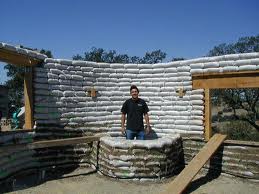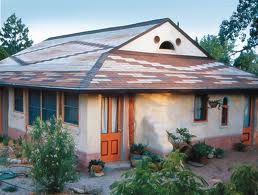Earthbag Construction

I just ran across another fascinating and beautiful building construction method called Earthbag Construction, which uses nothing more than some barbed wire, a shovel, bags and the earth beneath your feet.
Amazing. Earthen building currently house more than one third of the world’s population, although we here in North America lead pretty sheltered lives and know nothing about these fantastic homes!
Thousands of year ago, people discovered and utilized the principles of arch and dome construction. Earthbag construction uses earth as the primary structural element to create curvaceous, sensual architecture while providing strong and durable structures.
Bags laid horizontally and stair-stepped up to form a dome and designed with arch openings can eliminate 95 percent of the lumber used to build an average frame house.
Earthbag building utilizes the ancient techniques of rammed earth with modern polypropylene bags as a flexible form. The basic procedure is simple:
- Fill the bags using suitable pre-moistened earth.
- Close, fold and pin the bags to make neat square-cornered rectangles similar to grocery-store brown bags.
- Lay the finished bags in a masonry-style running bond.
- Thoroughly compact with hand tampers after a row has been laid.
- Lay two strands of four-point barbed wire, pushed down with bricks, between every row. This acts as a “Velcro mortar,” cinching the bags in place and providing exceptional tensile strength (resistance to lengthwise stress) while allowing the rows to be stepped, creating domes and other unusual shapes.
- Apply exterior and interior plasters.

Earthen walls function as an absorbent mass able to store warmth and re-radiate it back into the living space as the mass cools. This temperature fluctuation is known as the “thermal flywheel effect.” The effect of the flywheel is a 12-hour delay in energy transfer from exterior to interior. This means that at the hottest time of the day, the inside of an earthbag structure is at its coolest, while at the coolest time of the day, the interior is at its warmest. This delay is possible only in walls greater than 12 inches thick and can be modified by climate, house orientation, wall color and the placement of windows and doors.
So these buildings use energy efficiently and are beautiful too! They are labor intensive to build, although the materials are cheaper than wooden frame houses.
Dirt cheap, you could say, eh?
Stephanie Kelley
